CHEVROLET TAHOE 2011 3.G Workshop Manual
Manufacturer: CHEVROLET, Model Year: 2011, Model line: TAHOE, Model: CHEVROLET TAHOE 2011 3.GPages: 98, PDF Size: 1.55 MB
Page 51 of 98

Black plate (3,1)Chevrolet Tahoe and GMC Yukon/Yukon Denali Hybrid - 2011
Vehicle Care 10-3
2NOTES
Page 52 of 98
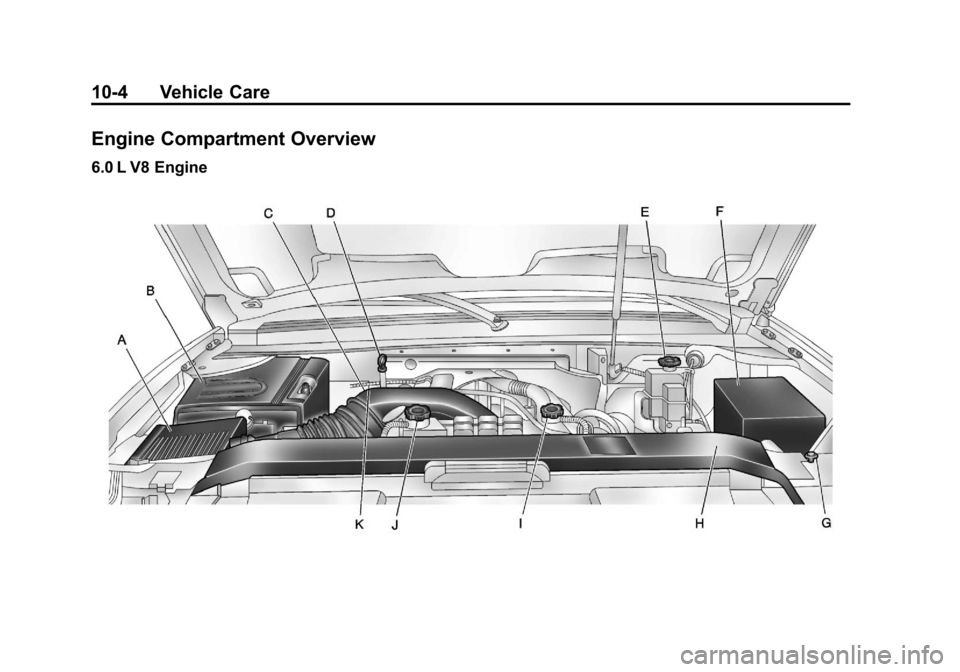
Black plate (4,1)Chevrolet Tahoe and GMC Yukon/Yukon Denali Hybrid - 2011
10-4 Vehicle Care
Engine Compartment Overview
6.0 L V8 Engine
Page 53 of 98

Black plate (5,1)Chevrolet Tahoe and GMC Yukon/Yukon Denali Hybrid - 2011
Vehicle Care 10-5
A. See“Engine Air Cleaner/Filter”
in the owner manual.
B. Drive Motor/Generator Control Module (DMCM). See Drive
Motor/Generator Control
Module (DMCM) Cooling
System on page 10‑9.
C. Engine Oil Dipstick (Out of View). See “Engine Oil” in the
owner manual.
D. Automatic Transmission Fluid Dipstick. See Automatic
Transmission Fluid on
page 10‑6. E. Brake Fluid Reservoir. See
“Brakes” in the owner manual.
F. See “Engine Compartment Fuse
Block” in the owner manual.
G. Windshield Washer Fluid Reservoir. See “Washer Fluid”
in the owner manual.
H. Hybrid Auxiliary Fuse Block (Out of View). See Engine
Compartment Fuse Block on
page 10‑15. I. DMCM Coolant Surge Tank
Pressure Cap. See Drive Motor/
Generator Control Module
(DMCM) Coolant Surge Tank
Pressure Cap on page 10‑9.
J. Coolant Surge Tank Pressure Cap. See “Engine Coolant” in
the owner manual.
K. Engine Oil Fill Cap (Out of View). See “Engine Oil” in the
owner manual.
Page 54 of 98
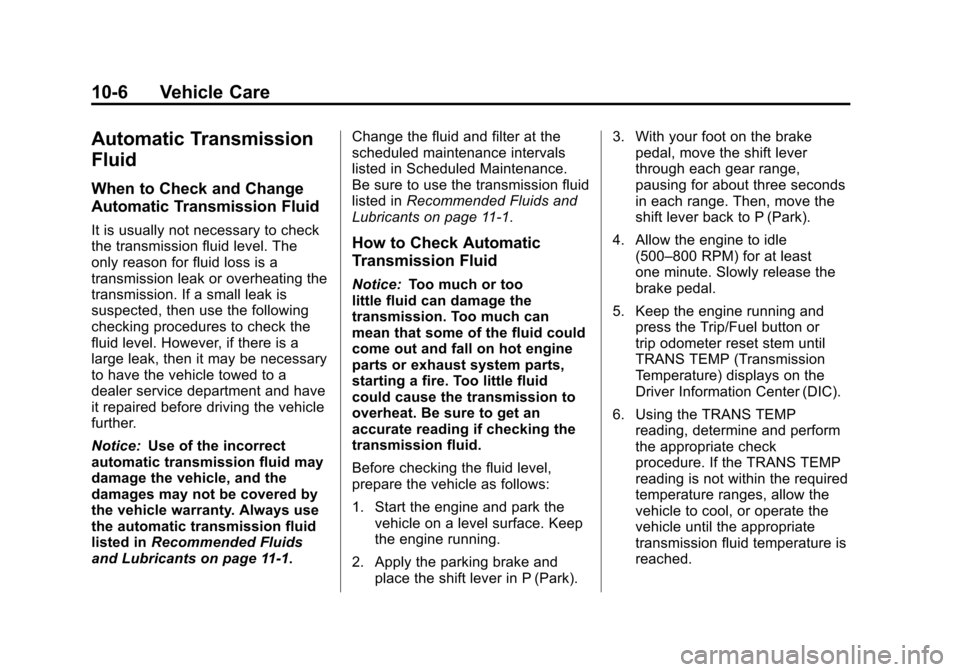
Black plate (6,1)Chevrolet Tahoe and GMC Yukon/Yukon Denali Hybrid - 2011
10-6 Vehicle Care
Automatic Transmission
Fluid
When to Check and Change
Automatic Transmission Fluid
It is usually not necessary to check
the transmission fluid level. The
only reason for fluid loss is a
transmission leak or overheating the
transmission. If a small leak is
suspected, then use the following
checking procedures to check the
fluid level. However, if there is a
large leak, then it may be necessary
to have the vehicle towed to a
dealer service department and have
it repaired before driving the vehicle
further.
Notice:Use of the incorrect
automatic transmission fluid may
damage the vehicle, and the
damages may not be covered by
the vehicle warranty. Always use
the automatic transmission fluid
listed in Recommended Fluids
and Lubricants on page 11‑1. Change the fluid and filter at the
scheduled maintenance intervals
listed in Scheduled Maintenance.
Be sure to use the transmission fluid
listed in
Recommended Fluids and
Lubricants on page 11‑1.How to Check Automatic
Transmission Fluid
Notice: Too much or too
little fluid can damage the
transmission. Too much can
mean that some of the fluid could
come out and fall on hot engine
parts or exhaust system parts,
starting a fire. Too little fluid
could cause the transmission to
overheat. Be sure to get an
accurate reading if checking the
transmission fluid.
Before checking the fluid level,
prepare the vehicle as follows:
1. Start the engine and park the
vehicle on a level surface. Keep
the engine running.
2. Apply the parking brake and place the shift lever in P (Park). 3. With your foot on the brake
pedal, move the shift lever
through each gear range,
pausing for about three seconds
in each range. Then, move the
shift lever back to P (Park).
4. Allow the engine to idle (500–800 RPM) for at least
one minute. Slowly release the
brake pedal.
5. Keep the engine running and press the Trip/Fuel button or
trip odometer reset stem until
TRANS TEMP (Transmission
Temperature) displays on the
Driver Information Center (DIC).
6. Using the TRANS TEMP reading, determine and perform
the appropriate check
procedure. If the TRANS TEMP
reading is not within the required
temperature ranges, allow the
vehicle to cool, or operate the
vehicle until the appropriate
transmission fluid temperature is
reached.
Page 55 of 98
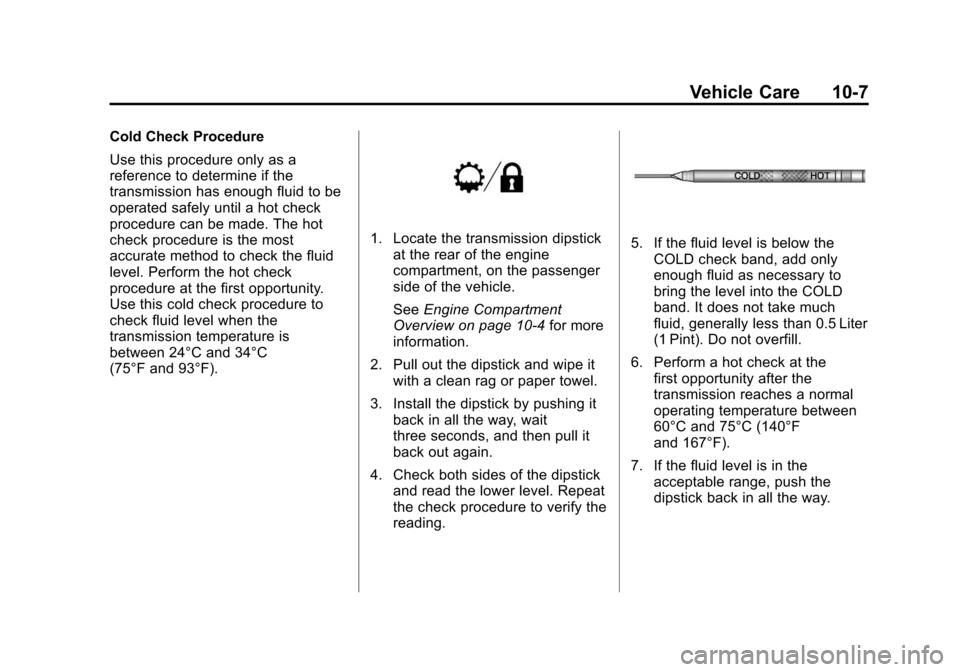
Black plate (7,1)Chevrolet Tahoe and GMC Yukon/Yukon Denali Hybrid - 2011
Vehicle Care 10-7
Cold Check Procedure
Use this procedure only as a
reference to determine if the
transmission has enough fluid to be
operated safely until a hot check
procedure can be made. The hot
check procedure is the most
accurate method to check the fluid
level. Perform the hot check
procedure at the first opportunity.
Use this cold check procedure to
check fluid level when the
transmission temperature is
between 24°C and 34°C
(75°F and 93°F).
1. Locate the transmission dipstickat the rear of the engine
compartment, on the passenger
side of the vehicle.
See Engine Compartment
Overview on page 10‑4 for more
information.
2. Pull out the dipstick and wipe it with a clean rag or paper towel.
3. Install the dipstick by pushing it back in all the way, wait
three seconds, and then pull it
back out again.
4. Check both sides of the dipstick and read the lower level. Repeat
the check procedure to verify the
reading.5. If the fluid level is below theCOLD check band, add only
enough fluid as necessary to
bring the level into the COLD
band. It does not take much
fluid, generally less than 0.5 Liter
(1 Pint). Do not overfill.
6. Perform a hot check at the first opportunity after the
transmission reaches a normal
operating temperature between
60°C and 75°C (140°F
and 167°F).
7. If the fluid level is in the acceptable range, push the
dipstick back in all the way.
Page 56 of 98
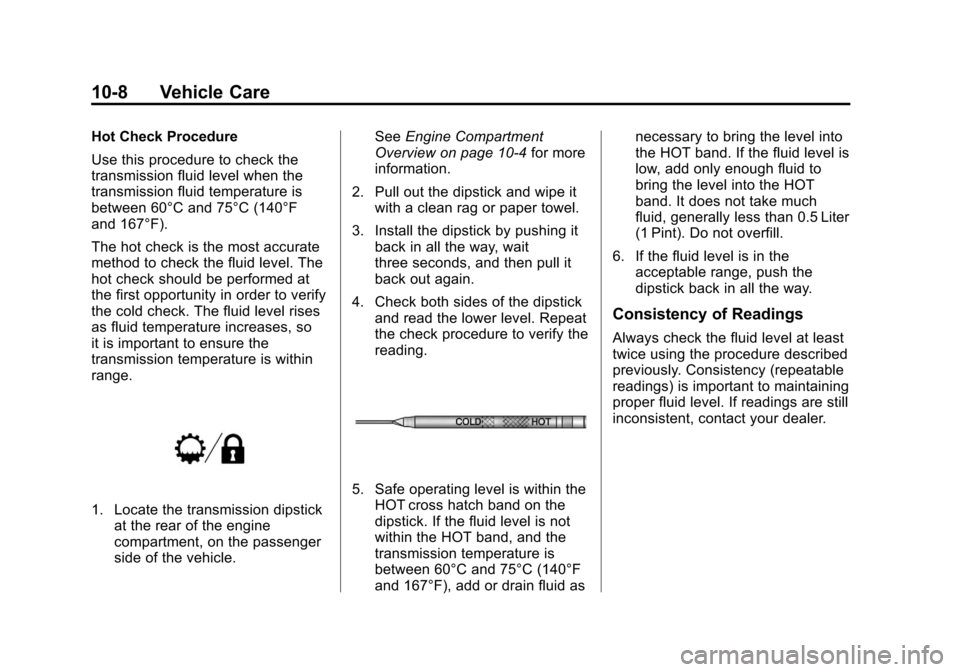
Black plate (8,1)Chevrolet Tahoe and GMC Yukon/Yukon Denali Hybrid - 2011
10-8 Vehicle Care
Hot Check Procedure
Use this procedure to check the
transmission fluid level when the
transmission fluid temperature is
between 60°C and 75°C (140°F
and 167°F).
The hot check is the most accurate
method to check the fluid level. The
hot check should be performed at
the first opportunity in order to verify
the cold check. The fluid level rises
as fluid temperature increases, so
it is important to ensure the
transmission temperature is within
range.
1. Locate the transmission dipstickat the rear of the engine
compartment, on the passenger
side of the vehicle. See
Engine Compartment
Overview on page 10‑4 for more
information.
2. Pull out the dipstick and wipe it with a clean rag or paper towel.
3. Install the dipstick by pushing it back in all the way, wait
three seconds, and then pull it
back out again.
4. Check both sides of the dipstick and read the lower level. Repeat
the check procedure to verify the
reading.
5. Safe operating level is within theHOT cross hatch band on the
dipstick. If the fluid level is not
within the HOT band, and the
transmission temperature is
between 60°C and 75°C (140°F
and 167°F), add or drain fluid as necessary to bring the level into
the HOT band. If the fluid level is
low, add only enough fluid to
bring the level into the HOT
band. It does not take much
fluid, generally less than 0.5 Liter
(1 Pint). Do not overfill.
6. If the fluid level is in the acceptable range, push the
dipstick back in all the way.
Consistency of Readings
Always check the fluid level at least
twice using the procedure described
previously. Consistency (repeatable
readings) is important to maintaining
proper fluid level. If readings are still
inconsistent, contact your dealer.
Page 57 of 98
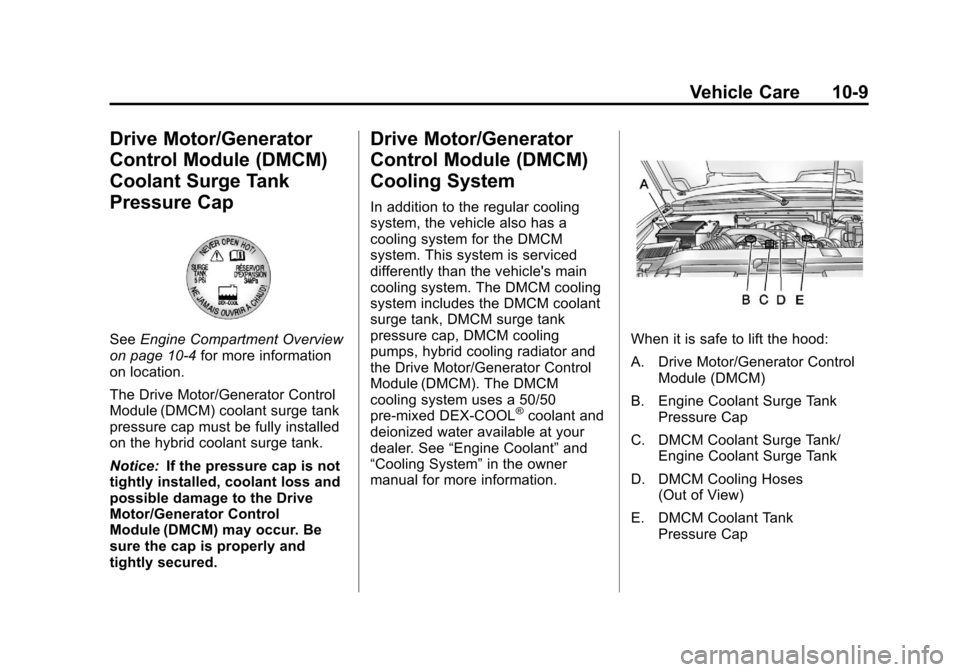
Black plate (9,1)Chevrolet Tahoe and GMC Yukon/Yukon Denali Hybrid - 2011
Vehicle Care 10-9
Drive Motor/Generator
Control Module (DMCM)
Coolant Surge Tank
Pressure Cap
SeeEngine Compartment Overview
on page 10‑4 for more information
on location.
The Drive Motor/Generator Control
Module (DMCM) coolant surge tank
pressure cap must be fully installed
on the hybrid coolant surge tank.
Notice: If the pressure cap is not
tightly installed, coolant loss and
possible damage to the Drive
Motor/Generator Control
Module (DMCM) may occur. Be
sure the cap is properly and
tightly secured.
Drive Motor/Generator
Control Module (DMCM)
Cooling System
In addition to the regular cooling
system, the vehicle also has a
cooling system for the DMCM
system. This system is serviced
differently than the vehicle's main
cooling system. The DMCM cooling
system includes the DMCM coolant
surge tank, DMCM surge tank
pressure cap, DMCM cooling
pumps, hybrid cooling radiator and
the Drive Motor/Generator Control
Module (DMCM). The DMCM
cooling system uses a 50/50
pre-mixed DEX-COOL
®coolant and
deionized water available at your
dealer. See “Engine Coolant” and
“Cooling System” in the owner
manual for more information.
When it is safe to lift the hood:
A. Drive Motor/Generator Control Module (DMCM)
B. Engine Coolant Surge Tank Pressure Cap
C. DMCM Coolant Surge Tank/ Engine Coolant Surge Tank
D. DMCM Cooling Hoses (Out of View)
E. DMCM Coolant Tank Pressure Cap
Page 58 of 98
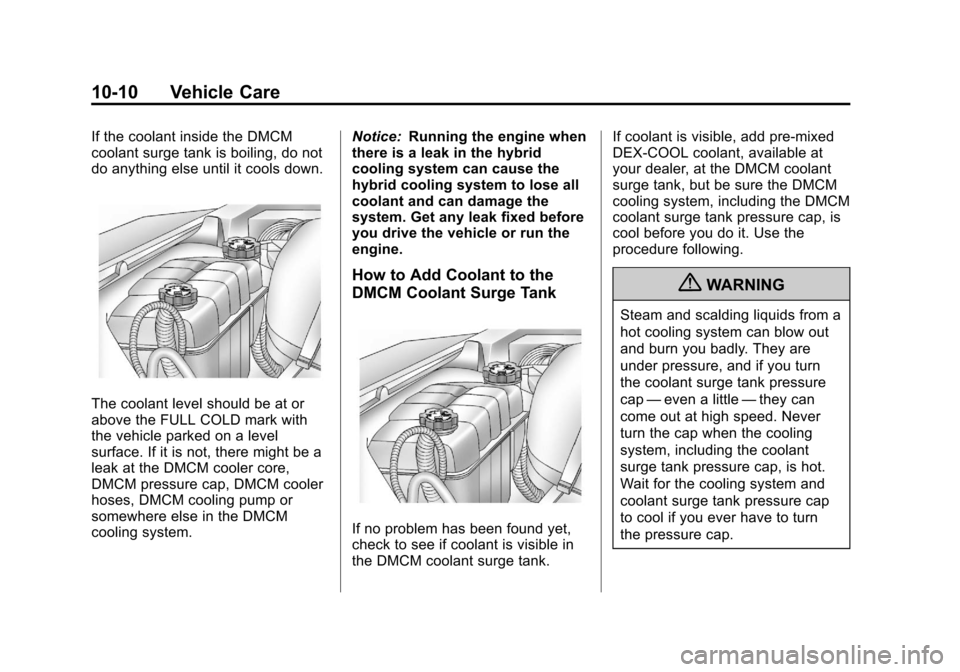
Black plate (10,1)Chevrolet Tahoe and GMC Yukon/Yukon Denali Hybrid - 2011
10-10 Vehicle Care
If the coolant inside the DMCM
coolant surge tank is boiling, do not
do anything else until it cools down.
The coolant level should be at or
above the FULL COLD mark with
the vehicle parked on a level
surface. If it is not, there might be a
leak at the DMCM cooler core,
DMCM pressure cap, DMCM cooler
hoses, DMCM cooling pump or
somewhere else in the DMCM
cooling system.Notice:
Running the engine when
there is a leak in the hybrid
cooling system can cause the
hybrid cooling system to lose all
coolant and can damage the
system. Get any leak fixed before
you drive the vehicle or run the
engine.
How to Add Coolant to the
DMCM Coolant Surge Tank
If no problem has been found yet,
check to see if coolant is visible in
the DMCM coolant surge tank. If coolant is visible, add pre‐mixed
DEX-COOL coolant, available at
your dealer, at the DMCM coolant
surge tank, but be sure the DMCM
cooling system, including the DMCM
coolant surge tank pressure cap, is
cool before you do it. Use the
procedure following.
{WARNING
Steam and scalding liquids from a
hot cooling system can blow out
and burn you badly. They are
under pressure, and if you turn
the coolant surge tank pressure
cap
—even a little —they can
come out at high speed. Never
turn the cap when the cooling
system, including the coolant
surge tank pressure cap, is hot.
Wait for the cooling system and
coolant surge tank pressure cap
to cool if you ever have to turn
the pressure cap.
Page 59 of 98
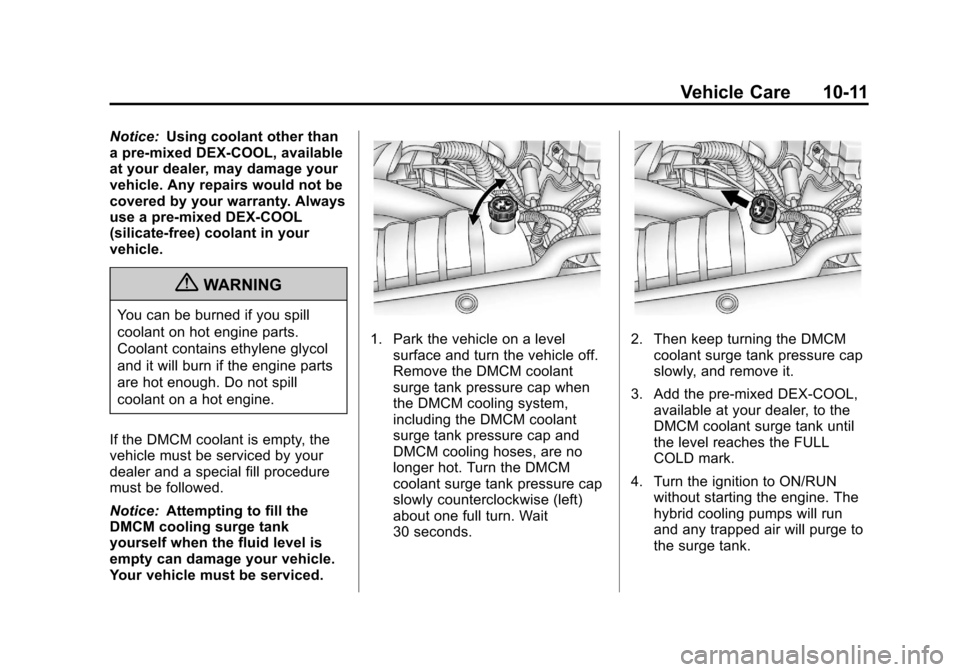
Black plate (11,1)Chevrolet Tahoe and GMC Yukon/Yukon Denali Hybrid - 2011
Vehicle Care 10-11
Notice:Using coolant other than
a pre‐mixed DEX-COOL, available
at your dealer, may damage your
vehicle. Any repairs would not be
covered by your warranty. Always
use a pre‐mixed DEX-COOL
(silicate-free) coolant in your
vehicle.
{WARNING
You can be burned if you spill
coolant on hot engine parts.
Coolant contains ethylene glycol
and it will burn if the engine parts
are hot enough. Do not spill
coolant on a hot engine.
If the DMCM coolant is empty, the
vehicle must be serviced by your
dealer and a special fill procedure
must be followed.
Notice: Attempting to fill the
DMCM cooling surge tank
yourself when the fluid level is
empty can damage your vehicle.
Your vehicle must be serviced.
1. Park the vehicle on a level surface and turn the vehicle off.
Remove the DMCM coolant
surge tank pressure cap when
the DMCM cooling system,
including the DMCM coolant
surge tank pressure cap and
DMCM cooling hoses, are no
longer hot. Turn the DMCM
coolant surge tank pressure cap
slowly counterclockwise (left)
about one full turn. Wait
30 seconds.2. Then keep turning the DMCMcoolant surge tank pressure cap
slowly, and remove it.
3. Add the pre‐mixed DEX‐COOL, available at your dealer, to the
DMCM coolant surge tank until
the level reaches the FULL
COLD mark.
4. Turn the ignition to ON/RUN without starting the engine. The
hybrid cooling pumps will run
and any trapped air will purge to
the surge tank.
Page 60 of 98
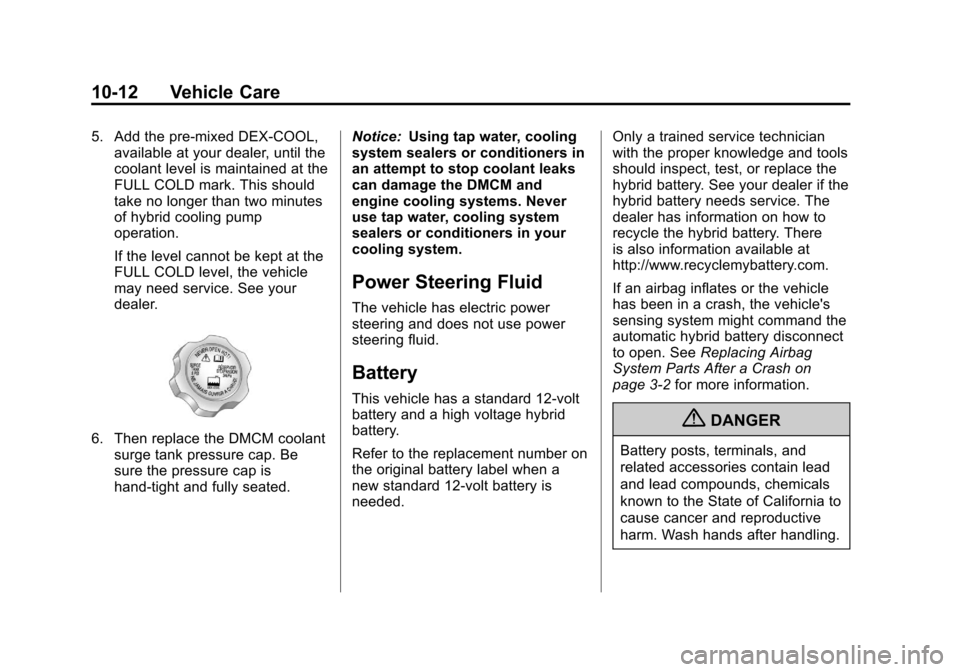
Black plate (12,1)Chevrolet Tahoe and GMC Yukon/Yukon Denali Hybrid - 2011
10-12 Vehicle Care
5. Add the pre‐mixed DEX‐COOL,available at your dealer, until the
coolant level is maintained at the
FULL COLD mark. This should
take no longer than two minutes
of hybrid cooling pump
operation.
If the level cannot be kept at the
FULL COLD level, the vehicle
may need service. See your
dealer.
6. Then replace the DMCM coolant
surge tank pressure cap. Be
sure the pressure cap is
hand-tight and fully seated. Notice:
Using tap water, cooling
system sealers or conditioners in
an attempt to stop coolant leaks
can damage the DMCM and
engine cooling systems. Never
use tap water, cooling system
sealers or conditioners in your
cooling system.
Power Steering Fluid
The vehicle has electric power
steering and does not use power
steering fluid.
Battery
This vehicle has a standard 12‐volt
battery and a high voltage hybrid
battery.
Refer to the replacement number on
the original battery label when a
new standard 12‐volt battery is
needed. Only a trained service technician
with the proper knowledge and tools
should inspect, test, or replace the
hybrid battery. See your dealer if the
hybrid battery needs service. The
dealer has information on how to
recycle the hybrid battery. There
is also information available at
http://www.recyclemybattery.com.
If an airbag inflates or the vehicle
has been in a crash, the vehicle's
sensing system might command the
automatic hybrid battery disconnect
to open. See
Replacing Airbag
System Parts After a Crash on
page 3‑2 for more information.
{DANGER
Battery posts, terminals, and
related accessories contain lead
and lead compounds, chemicals
known to the State of California to
cause cancer and reproductive
harm. Wash hands after handling.